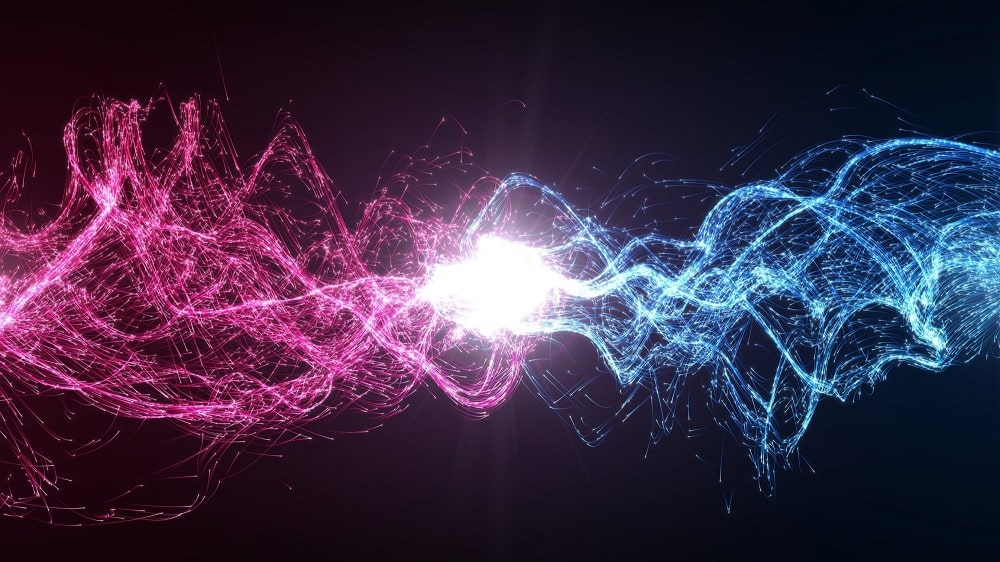For centuries, physicists have endeavored to unravel the secrets of matter. From the ancient Greeks to Newton to Einstein and Maxwell, these renowned scientists have all attempted to identify the most fundamental constituent of the matter around us. With quantum mechanics, the theory of wave-particle duality has offered some answers to this question. With the advent of quantum field theory, the Standard Model and superstring theory, several fundamental elements have been proposed. And recently, two theoretical physicists also suggested another hypothesis: matter could be basically composed of fragments of energy.
About 300 years ago, Isaac Newton introduced the idea that all matter exists at points called particles. One hundred and fifty years later, James Clerk Maxwell introduced the electromagnetic wave. The particle has served as the building block for mechanics and the wave for electromagnetism – and science has settled on the particle and the wave as the two building blocks of matter. Together, particles and waves have become the building blocks of all kinds of matter.
This was a great improvement over the five elements of the ancient Greeks, but it was still imperfect. In a famous series of experiments, known as the double slit experiments, light sometimes acts as a particle and at other times as a wave. And while wave and particle theories and mathematics allow scientists to make incredibly accurate predictions about the Universe, the rules crumble at the largest and tiniest scales.
Einstein proposed a solution in his theory of general relativity. Using the mathematical tools he had at the time, Einstein was able to better explain certain physical phenomena and also resolve a long-standing paradox related to inertia and gravity. But instead of improving the particles or the waves, he eliminated them by proposing the deformation of space and time.
A mechanism underlying the wave-particle duality
Using new mathematical tools, the authors of the article in the journal Physics Essays proposed a new theory that could accurately describe the Universe. Instead of basing the theory on the deformation of space and time, they considered that there might be a more fundamental building block than the particle and the wave.
Scientists understand that particles and waves are existential opposites: a particle is a source of matter that exists at a single point, and waves exist everywhere except at the points that create them. However, the two physicists started with the following hypothesis: there should be an underlying mechanism linking these two physical representations.
Fragments of energy: they would be the basis of matter
The theory begins with a new fundamental idea: energy always “circulates” through regions of space-time. Think of energy as being made up of lines that fill a region of space and time, moving in and out of that region, never starting, never ending, and never intersecting.
Starting from the idea of a universe of fluid energy lines, the authors sought a single constituent element of energy in motion. By finding and defining such a thing, they hoped to be able to use it to make accurate predictions about the Universe on a large and small scale. There were many building blocks to choose from mathematically, but physicists looked for one that had both the characteristics of the particle and the wave – concentrated like the particle but also distributed in space-time like the wave.
The chosen element is a building block that looks like a concentration of energy having the highest energy at the center, and which decreases further and further from the center. The authors discovered that there were only a limited number of ways to describe a flowing concentration of energy. Of these, only one worked according to the mathematical definition of flux.
They called it energy fragment. This element is defined as A = -⍺ / r, where ⍺ is the intensity and r is the distance function. Using the fragment of energy as the building block of matter, researchers developed the mathematics needed to solve problems in physics. The last step was to test this new mechanism.
A hypothesis compatible with the predictions of general relativity
Over 100 years ago, Einstein turned to two problems in physics to validate general relativity: the precession in the orbit of Mercury and the tiny curvature of light as it passes in front of the Sun. These issues were at the two extremes of the size spectrum. Neither the theories of waves nor those of the particles of matter could solve them, but general relativity did.
The theory of general relativity admits the deformation of space-time to explain the displacement of the trajectory of Mercury and the curvature of light in the exact proportions defined by astronomical observations. If the new theory were to have a chance of replacing the particle and wave with a more fundamental fragment, it should also be able to solve these problems.
More advertising + Premium items?
Subscribe for only 1.3 € / month!
Promo code 35% discount (only for the first 1000!) : 0pub35pourcent
—
–
–
For the problem of the precession of Mercury, the authors modeled the Sun as a huge stationary fragment of energy and Mercury as a smaller, but still very large, slow fragment of energy. For the problem of the curvature of light, the Sun was modeled in the same way, but the photon was modeled as a tiny fragment of energy moving at the speed of light. In both problems, the researchers calculated the trajectories of the moving fragments and obtained the same answers as those given by the general theory of relativity.
Video presenting the work of the researchers:
Sources : Physics Essays
–

